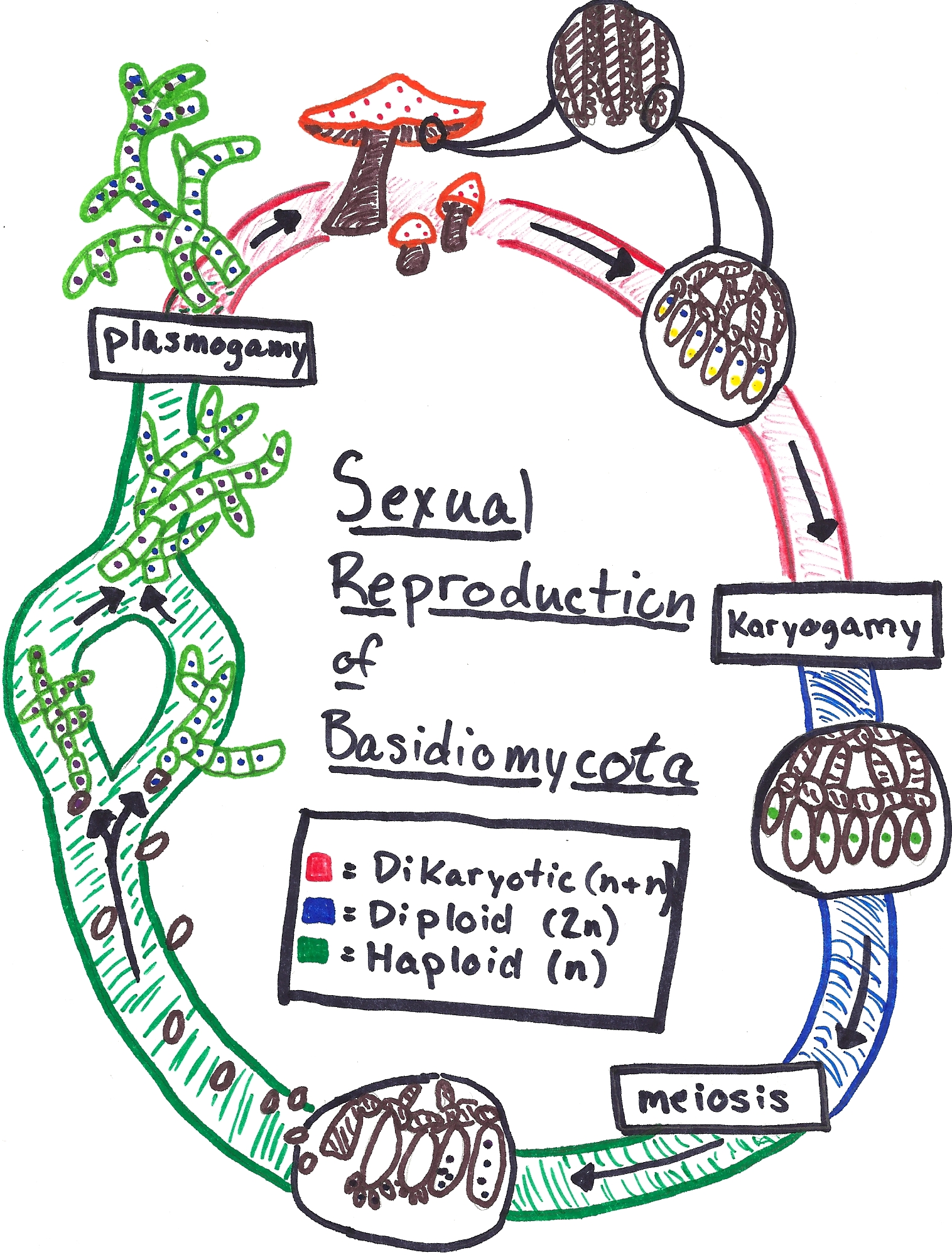Reproduction-
The figure below illustrates the Basidiomycota life cycle. Once again, the Basidiomycota phylum includes an enormous amount of other species along with P. cubensis. The text below the illustration further explains the life cycle. For clarity, the red, blue, and green text describes their corresponding areas on the life cycle illustration.

Like all other mushrooms, the P. cubensis fruiting body (also basidiocarp, or mushroom) is the only stage of the life cycle that is visible to us in nature. The ploidy of the fruiting body is a peculiar one. Termed as 'dikaryotic, or (n+n)' this ploidy is characterized by the presence of two nuclei in each cell (Merriam-Webster). Each of these nuclei are haploid nuclei, which will be discussed later in this section. In all other known life forms, this stage never occurs so it remains exclusive to the fungi. As a comparison, this would be equivalent to a human sperm uniting with an egg and remaining side by side in the same cell for a length of time. However, like all other animals, the human sperm nucleus fuses with the egg nucleus almost instantaneously upon entering (fertilization). In fungi, this stage is present in almost the entire fruiting body. The underside of the fruiting body is composed of a gilled tissue. The gilled shaped is advantageous to the mushroom because it increases the surface area, which is crucial when considering its function; producing spores. If you've ever picked up a mushroom and examined its underside, you've probably noticed that these gills are paper thin. These paper thin structures give rise to basidia (singular, basidium). Within each basidia, the two nuclei types fuse in a process known as karyogamy, which translates literally to the joining of two nuclei.
After karyogamy occurs, the ploidy of the basidium is now diploid (2n), meaning that the nucleus contains two sets of chromosomes. Humans (animals) are diploid their entire life from the moment of fertilization. Once diploid, the nucleus almost immediately undergoes meiosis to produce 4 haploid (n) nuclei.
Keep in mind that each basidium is extremely small. Its been found that an entire basidiocarp (mushroom) is able to produce up to 4.5 trillion basidia in a single growing season! (Sadava et al.). Recall that the function of the basidiocarp gills is to increase the surface area of the underside. This is exactly why! With so much surface area, the basidiocarp is able to produce an incredible amount of basidiospores, thus increasing its chances of reproduction. The basidiospores are then released from the gilled surface and carried by the wind to a new destination. Keep in mind that each basidiospore contains one haploid nucleus. If a basidiospore happens to be one of the lucky few (quite literally 'one in a million') they germinate and undergo mitosis and develop into fine, branching, tube-like structures known as hyphae (Biology-Online). Together, large amounts of hyphae (singular, hypha) form an underground, net-like structure called a mycelium (plural, mycelia). When this haploid mycelium comes into contact with another mycelium of the opposite mating type, they undergo plasmogamy. This means that their cells fuse, however, their nuclei do not. The two haploid nuclei are now in the same cell, which means the ploidy is now...
dikaryotic!!! This brings us back to the beginning of the cycle. The dikaryotic mycelium continues to grow and will eventually develop into a fruiting body above the surface. The cycle repeats itself!
Now, we will cover some interactions among P. cubensis!